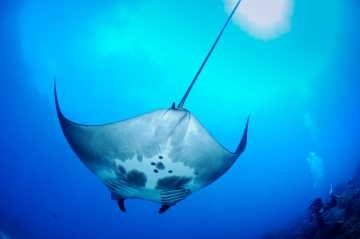681123_Manta Colony_360 px width.jpg

Manta rays have unique dot patterns on their undersides that scientists can use to tell one ray from another. Credit: National Marine Sanctuaries, NOAA.
The giant oceanic manta ray is one of the most graceful fish on Earth—and one of the biggest. Its “wings” can span 20 feet or more. It flaps them gently as it glides through the ocean.
The rays generally are found in groups of no more than a thousand or so. Yet scientists recently discovered the largest congregation of them ever seen, off the coast of Ecuador—an estimated population of more than 22 thousand.
The giant oceanic ray is one of two species of manta ray. The other stays in shallow waters, and is a good bit smaller. The giants are found in warm waters around the world. They can weigh a couple of tons, and live for up to 40 years.
Scientists discovered the giant group of them by counting rays from 2005 to 2018. The scientists used their own observations, plus thousands of photos snapped by recreational divers. Each ray has a unique pattern of dots on its underside, making it easy to identify them—about 2800 rays in all. The researchers then used mathematical models to estimate the total population.
The rays may congregate off Ecuador because the area is teeming with krill and other tiny organisms that the rays filter from the water. That also brings many other fish, so it's a popular area for commercial fishing operations. And that's a problem for the rays. They're an endangered species, and they're easily entangled in fishing gear. So the giant population of giant manta rays could shrink in the years ahead.

